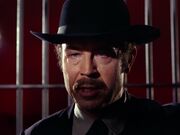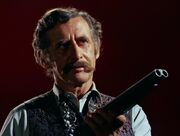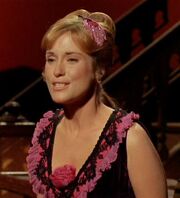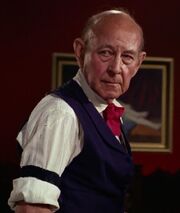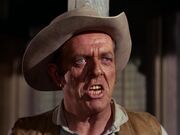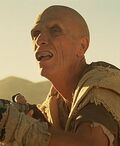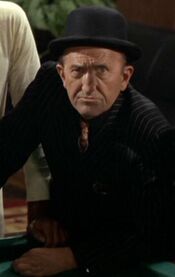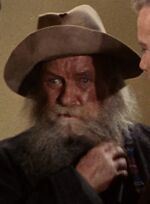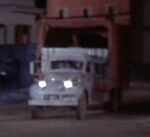“Look, I’m a first-time director …”
Author Archives: Tom Crippen
Wiki Trek: “Spectre of the Gun”
… Scotty did the voice for the warning device sent up by the aliens (which Mem Alpha i.d.s as “Melkotian buoy”—“buoy” is odd, but nobody’s on board the thing so what else do you call it?)
… There was an early ’60s tv Western called The Tall Man. What a great name.
I’m going to start with the unspeaking slain rancher. Born as Palmer Lee in San Francisco, 1927, stage name was Gregg Palmer. In “Spectre” he gets plugged and falls over; this is right when the Enterprise crew has first arrived in the old West.
Why start with him? Because, if you want to read Wiki entries about minor ’60s tv actors, this is the greatest Wiki entry ever. It goes on for show after show, part after part. Gregg got his first role in 1950, a Martin and Lewis vehicle called My Friend Irma Goes West. Then, from 1955 to 1978, he did nothing except stand in front of cameras, mostly while episodes of tv Westerns were being shot. The entry’s got character names, episode titles, co-stars: 14 paragraphs of this stuff. Palmer was “Burly Man” in John Wayne’s last movie.
Somehow he also got over to England and appeared in two episodes of Doctor Who, the episode that closed off the first Doctor’s run and the episode that did the same for the second Doctor. Not major parts, but credited. Wiki says Gregg is the first actor to do both Star Trek and Doctor Who.
All right, the rest of the actors. They’re good. Like “Devil in the Dark,” this is a real line-up of mugs, hard-bitten masculine types, but “Spectre” has a much better selection. Apparently Hollywood had great choices to offer if you were looking for Western types.
Villains are often a weak point of old Trek casting. Not this time. We have a very good Wyatt Earp, b. 1928, Chicago. The guy is scary. He did some notable manly films of the late ’60s/early ’70s: True Grit, Papillon, Chisum. His first film: Roger Corman’s I, Mobster (1958), which also had Celia Lovsky. “His last film role was an uncredited appearance as a judge in the popular comedy Deuce Bigalow: Male Gigolo.” Died “from lung and brain cancer in 2002.”
The Virgil Earp, also good, b. 1913. The voice of the announcer on the castaways’ radio in Gilligan’s Island, which Wiki says was his longest-running role. Did a lot of series westerns in the ’60s, including 8 different Bonanzas as different characters. (Mem Alpha and Wiki)
The Doc Holliday, b. 1915 in Lynn, Mass. Did some tv western guest shots in ’60s, also a bunch of Brando films. First role was a cameo in The Men, kept on a with a bunch of other Brandos in ’50s/early ’60s, then pops up in The Missouri Breaks (1976).
Chekov’s love interest: the blond bargirl, b. 1941. This was her next-to-last acting role. She’d done guest spots on a number of shows: The Fugitive, Gunsmoke, The Invaders, started with a Twilight Zone in 1964 in which she’d been the central character, a folk singer. Had been Bob Dylan’s girlfriend in college, possibly inspired “Girl from the North Country.” In 1965 she married Wavy Gravy. Mem Alpha: “The two are still married, and Beecher now goes by the name Jahanara Romney. With her husband, she helps run a number of charitable organizations.”
Ed the barkeep, b. 1897, NYC. He’s good; he carries the scene where he reacts to Kirk’s claim to be from the future, etc. (by “react,” I mean he breaks up and guffaws elaborately). His credits all seem to be from the mid-’50s into the ’60s, last is Westworld (1973). Lot of Westerns, including tv work and some John Fords.
The sheriff, actor b. 1915 in NYC. TV/movie work from late ’50s on, but entry also says he was in Honeymooners. Last roles are in first Ace Ventura and Naked Gun: The Final Insult.
The barber, b. 1930, Philadelphia. Vincent McEveety put him into five episodes. The thing is, I’d say McCready was quite good; wonder why the other directors didn’t use him.



The Morgan Earp, one hell of a scary face. The actor did an album “called Here in the Land of Victory. It featured a mix of country, blues, and eastern influenced folk.” Born 1928 in Denver, also appeared in Star Trek V, “his last known screen appearance.”
Latter shot directed by Shatner — naturally.
This is pretty good
Another phishing mail. I like the detail, and the “k” on Kasper.
Dear G-mail user,
Your e-mail has emerged as a winner of £500,000.00 GBP (Five hundred
thousand British Pounds) in our on-going Google Promotion. Your Winning
details are as follows: Computer Generated Profile Numbers
(CGPN):7-22-71-00-66-12, Ticket number: 00869575733664, Serial
numbers:/BTD/8070447706/06, Lucky numbers: 12-12-23-35-40-41(12). Contact
Mr Graham Benfield, for more details through the contact below:
Mr Graham Benfield,Email: [ redacted]@
gmail.com Sincerely,
Mr. Kasper Simpson.
Wiki Trek: “Operation: Annihilate!”
You look at them, you want to look away. And the episode’s whole story is pretty much the crew members trying to dodge the things, which jerk thru the air at tight angles and in straight lines, making for a pervasive anti-plausibility. “Operation: Annihilate!” is a stinker like that one where the guest had a dreadful beard and the trippy optic effects were so painful. Looking at the screen becomes a mug’s game, and as a result I’m still not sure what happened in this episode except that it involved the things that made me want to look away: in this case, rubber pancakes of dog vomit that fly.
The vomit pancakes were designed by Wah Chang, who is spoken of highly by Inside Star Trek. I can’t sign on there. The pancakes, the Gorn (“Arena”), the yeti (“Galileo VII”), the yeti-plus-spines-plus-horn-plus-tail (Mogotu, I think–it was in “A Private Little War”): put them all together and you’ve got “oy.” I admit that the pancakes, at least, are heavily detailed and richly molded; otherwise they wouldn’t be so disgusting. But they look like objects, not specimens, so they’re not convincing. The Gorn and the rest also fail to convince, and on top of that they look like crap. I think Wah Chang’s big value was probably that he could do big projects fast (a man-size suit or a dozen vomit pancakes count as a big project) and they wouldn’t fall apart.
Mem Alpha says the planet exteriors were shot at the “headquarters of TRW in Redondo Beach, California (currently the Northrop Grumman Space Technology headquarters).” … First appearance of McCoy’s lab, and it’s got one of the people-holding sleep pods from “Space Seed.”
Actors: not a lot of them. Here’s Jim Kirk’s sister-in-law.
She tells them the horrible thing that happened to the earth colony, then dies with enough agony to have caused some local tv stations to trim the scene in syndication. (Possibly without intent of adding more commercials: I read that, at least in the ’70s, the stations showing Trek kept the episodes intact for fan acceptability. Instead it was a case of local papers assigning suitability grades to tv shows in their listings.)
The actress, Joan Swift, was born in Sacramento, no birth year given. Her credits appear to be concentrated in the ’60s and include The Jack Benny Program and The Andromeda Strain (1971). She did some other Desilu work: The Lucy Show, I Spy. Latest available credit is Lucy Gets Lucky, a Lucy Ball tv movie from 1975.
Girl redshirt: In the landing party when it gets attacked, but nothing happens to her. The actress was in a couple of movies and that was it. One was a Presley vehicle with a great title: Stay Away, Joe (1968).
Her redshirt’s last name is Jamal, which is part of a pretty steady background effort by old Trek to infiltrate the screen with non-white bread Enterprise hands. Actress’s name is great: Maurishka Taliaferro.
Man, is she pretty. Makeup isn’t my thing, but I’m guessing the look here is very ’60s and Twiggy-like — I mean the way the eyes are done up.
Afflicted stunt man, b. 1923 in Texas, did a lot of work from late 1940s on, retired in late 1970s. Here he’s just a member of the earth colony emoting because of the parasites:
Another of the planet guys. The actor had bits in the 1954 Star Is Born and Scorsese’s New York, New York. To me, looking at that photo, it’s a surprise that he was a bit player. He’s got regular features but a lived-in sort of face, a good combo for tv work, and his expression here looks like it’s got something going on.
Also emoting, a second stunt man (Jerry Catron, no birth year; credits seem okay but concentrated in 1960s):
The redshirt is also Catron and appeared in “Doomsday Machine” and “Journey to Babel,” which are second-season eps; “Annihilate” was the last ep made for the first season. For the record, Mem Alpha gives the redshirt’s name as Montgomery.
Overheard: the power of Frank Miller
It’s the end of summer and the students are back, and tonight packs of them are ranging up and down St-Laurent Blvd, making noise outside the cafes and bars. So are white tow trucks with the lights going on top of their cabs, because for some reason each truck has three yellow alarm lights planted up there in a row, like sirens. Either the sirens or the trucks’ horns are making a racket. I don’t know what any of this is about.
“Snow, Glass, Apples”
Wiki Trek: “City on the Edge of Forever
Joan Collins (b. May 23, 1933, in London)! Her dad was Jewish and from South Africa. Holy shit, Wiki says he was agent for Tom Jones, Shirley Bassey and the Beatles. (They had someone besides Epstein? Wiki’s Beatles timeline turns up nothing for Collins.) Anyway, from the client list it sounds like the dad was hitting his career peak just when his daughter was making it as a starlet.
She trained at RADA, which I didn’t expect, signed with J. Arthur Rank at 17, First movie was Lady Godiva Rides Again (1951). Signed with 20th Century Fox in 1954 as “their answer to Elizabeth Taylor” (Wiki), was “popular as a magazine pinup in the UK throughout the 1950s and into the 1960s.”
… Only two lines of Ellison’s script made it into the final, per Memory Alpha.
Look at this guy (John Harmon, b. 1905). He’s a bum in the mission, but he was also Tepo, the Durante-like gangster in “Piece of the Action” (the one who got transported in his underwear and said “Mamma!”). About 200 parts over the years, including a Buck Rogers serial in 1939. In 1975 he played “Old Hippie” on The Odd Couple.
“His career spanned seven decades and almost three hundred movie roles and television guest spots, many of them uncredited. Most of his television work was in the 1960s; he was a staple in television of that era …”
Soup kitchen drunk. Actor, b. 1918, played “the hotel clerk for the entire run of Gunsmoke” and showed up a lot on Dragnet. (Name: Howard Culver)
The fellow who drives the truck that hits Joan Collins is the same guy who drove the truck in Duel! Carey Loftin, (1914 –1997, he had an amazing career. Stunt coordinator for THX 1138, The Deer Hunter and The Goonies, which is quite a spread, career-wise, and he drove for Bullitt, The French Connection and The Getaway. I really had no idea.
“Statler was one of the founding and charter members of the Stuntwomens Association of Motion Pictures in 1967 alongside fellow Star Trek stuntwomen Regina Parton and Donna Garrett.”



